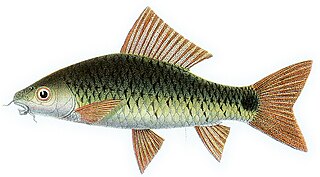
Pieter Bleeker was a Dutch medical doctor, ichthyologist, and herpetologist. He was famous for the Atlas Ichthyologique des Indes Orientales Néêrlandaises, his monumental work on the fishes of East Asia published between 1862 and 1877.

Osteochilus is a genus of freshwater ray-finned fish belonging to the family Cyprinidae, the family which includes the carps, barbs, minnows and related fishes. The fishes in this genus are mainly found in Southeast Asia with a few extending into adjacent parts of China.

Dabu-dabu is a type of spicy condiment commonly found in Manado cuisine of North Sulawesi, Indonesia. Dabu-dabu consists of diced red chili peppers, bird's eye chili, shallots, red and green tomatoes, salt, sugar, and mixed with fresh calamansi juice locally known as lemon cui or jeruk kesturi, sometimes replaced by kaffir lime or lemon juice. The chili pepper and citrus gives it a fresh, sour, and spicy flavour.

Colo-colo is an acidic condiment commonly found in Maluku archipelago, Indonesia. It is believed to have originated in Ambon city, and accordingly is often described as Ambon's sambal. Colo-colo is similar to Manado's dabu-dabu, as they both use many chopped red chili peppers, bird's eye chili, shallots, red and green tomatoes, and a pinch of salt and sugar, mixed with fresh calamansi juice or locally known as lemon cui or jeruk kesturi. The main difference is that colo-colo recipe often includes additional ingredients, such as chopped lemon basil, kenari nut, and tahi minyak or ampas minyak, or caramelized rarobang. As a result, colo-colo is darker and more oily than dabu-dabu.
Osteochilus lini is a freshwater fish from Southeast Asia. It is found in the lower Mekong River basin, the Chao Phraya River basin, and some coastal drainages; it occurs in Laos, Vietnam, Cambodia, and Thailand. Its common name is dusky face carp.

Osteochilus microcephalus is a cyprinid freshwater fish from Southeast Asia.

Osteochilus spilurus is a cyprinid freshwater fish from Southeast Asia. It is found in Thailand, Peninsular Malaysia, Sumatra, Java, and Borneo. It grows to 7.5 cm (3.0 in) SL.

Osteochilus vittatus is a species of cyprinid fish from Southeast Asia. Its common name is bonylip barb,Hasselt's bony-lipped barb, hard-lipped barb, or silver sharkminnow. It grows to 32 cm (13 in) SL.

Osteochilus waandersii is a cyprinid freshwater fish from Southeast Asia. It is found in Indochina as well as in Sumatra and Borneo. Its common name is Waanders's hard-lipped barb.
Osteochilus brachynotopteroides is a fresh water fish in the family Cyprinidae from Southeast Asia. It occurs in the lower Mekong Basin and is present in Laos, Thailand, and Vietnam; it is expected to occur in Cambodia but has not been found there.
Osteochilus kerinciensis is a species of cyprinid fish. It is endemic to Sumatra (Indonesia). It is known from the upper reaches of the Batang Hari River basin, including upstream tributaries and highland lakes. The specific name kerinciensis refers to its type locality, Lake Kerinci.
Osteochilus bellus is a species of cyprinid fish endemic to eastern Borneo.
Osteochilus chini is a species of cyprinid fish in the Labeoninae endemic to Sabah.

Osteochilus enneaporos is a species of cyprinid fish found from Thailand to Indonesia.
Osteochilus salsburyi is a species of cyprinid fish found in Laos, northern Vietnam, and southern China.
Osteochilus sarawakensis is a species of cyprinid fish. It is endemic to northern Borneo and occurs in Malaysia and in Brunei. It occurs in mountain streams in the upper reaches of river basins with forested vegetation, clear water, and rapid current.

The giant sharkminnow a species of cyprinid fish found in southeast Asia.
Osteochilus serokan is a species of cyprinid fish endemic to Sumatra.
Betta dennisyongi is a species of gourami. It is native to Asia, where it occurs on the island of Sumatra in Indonesia, ranging from Meulaboh to Singkil. It is typically seen in lowland hillstreams and acidic swamps with clear to brown water, including farmland environments. It is known to occur alongside the species Kryptopterus piperatus, Mystus punctifer, Nemacheilus tuberigum, Ompok brevirictus, Osteochilus jeruk, Rasbora jacobsoni, and Rasbora kluetensis. The species reaches 3.5 cm in standard length and is known to be a facultative air-breather.









